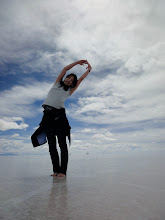


LIVE WIRE, sciarc gallery opening by OylerWu Collaborative.
Network of 1" diameter aluminum pipes -looking challenging enough to stand up on its own weight- are linking the floor level up to the walkway above the gallery space. The stair portion and wing portion are structurally independent from each other, yet all the looping pipes weave together, so live load transfers to the entire piece and vibrate the spanning wings. I think LIVE WIRE is matching name. I have been calling this piece "stairs" the whole time though.
Hardest thing for me was to prepare a CATIA model for two different purposes: one for engineering analysis and the other for fabrication. The former requires to all the bars start and end at points (point to point) to visualize the load path and deformation, while the latter has to consider offset for pipe thickness and fillet at corners.
LIVE WIRE in progress.
Working on angle optimization.
階段部分と羽 (のような) 部分の構造は互いに独立していますが実際にのぼりおりしてみると羽の部分が揺れるので、LIVE WIRE とはなんとも面白いタイトルだとは思います。 が、構造が stable ではないみたいに聞こえて BH からみたら笑えないタイトルなんではないかな、と思いました。エンジニア達は誰もそんなことに気にしていない様子だったけれども。








